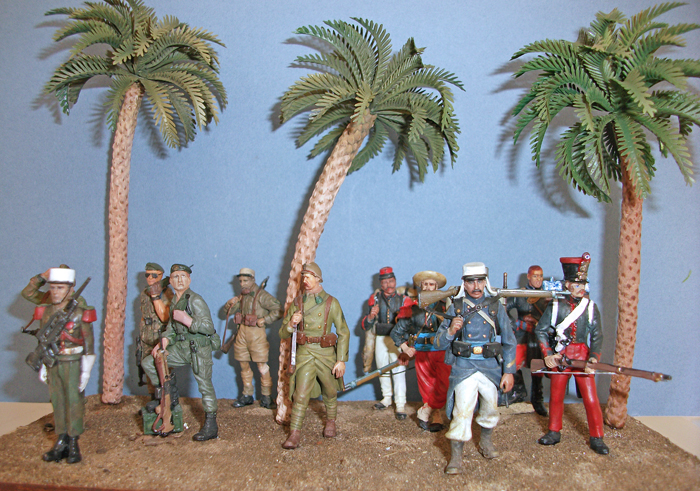
with Steve Noble
Introduction
Surrounded by mystique and legend, the French Foreign Legion has become a topic of great interest to many. Portrayed as a home for the romantic adventurer, it has a reputation for harsh discipline, toughness in combat and succeeding against the odds. Its standing today places it as one of the World’s elite fighting forces, but its origin was much more humble.
The Foreign Legion owes its origins to the chaos in France that followed the defeat and exile of Napoleon leaving the country in a political shambles. The reinstatement of the Royal line was faced with a succession of claimants seeking the throne along with groups who wanted the Republic re-formed.
By the start of the 1830’s, Paris was a tinderbox which was about to be fuelled by the disbandment of a mixture of foreign and domestic regiments serving under the French flag. Adding to the problems, France was engaged in an unpopular and losing war, suffering a high casualty rate to combat and illness against Algerian tribesmen.
The answer to the problem came from the Minister of War, Marshall Soult of Napoleonic fame, who proposed creating a Foreign Legion closed to French citizens to serve French interests outside its borders. In a creative but highly cynical political manoeuvre, Soult could empty Paris while replacing French troops in Algeria with foreign soldiers whose loss would raise little concern amongst the French population.
The Legion got off to a poor start with a reputation of ill-discipline and unreliability. Considered as only suitable for construction work, its officers and NCO’s introduced a tough set of measures. As encounters between the Legion and the tribesmen grew so did the Legion’s reputation and standing.
Seen as a cheap solution to meet France’s commitments, it was often mis-used to support French allies in civil wars and conflicts in Italy, Spain, the Crimea and Mexico. Despite the lack of political support, it would establish a reputation for courage and fighting spirit. The link to Algeria in particular and North Africa in general would remain strong until these colonies and protectorates gained independence in the latter half of the 20th Century.
The Diorama…
In thinking how best to represent the history of the Legion, I chose to put together a collection of 54mm scale figures in uniforms spanning the period from its formation to current times. The figures were set against a generic background designed to accept figures which would have fought in lands as diverse as North Africa to the Crimea. The use of palm trees in the diorama was to suggest the strong connection of the Legion with Africa.
Where available, stock figures were used. Where they did not exist, figures were converted using selected parts from the multi-pose Airfix Historic figures series and accessorising with Historex spare parts. Construction of the converted figures is outlined at the end of the article.
The Beginning and Early Years 1830’s/1840s
At its formation, the Legion was to be equipped in line with the uniform of the day but was often supplied with motley and substandard equipment. The working dress consisted of a plain short single-breasted jacket (veste) in temperate and hot climates supplemented by the greatcoat (capote) for cold weather.
Issued to the Legion in 1831 its dress uniform was essentially Napoleonic in design still using a flintlock musket as the standard weapon represented by the figure below.
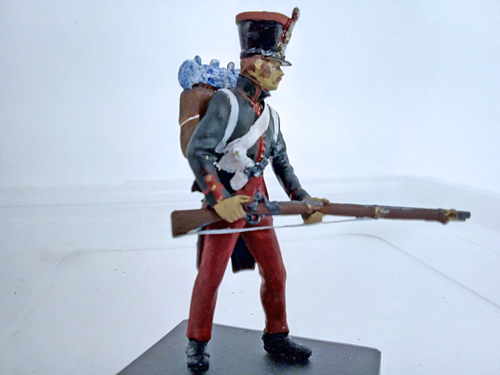
The figure was a conversion using the 95th rifleman body with the three rows of buttons trimmed off to leave a single row on the jacket. The short coat tails were removed and replaced with long coat tails from Historex. Airfix parts from the French line infantry and Guards kits provided the head, arms, shako, cartridge pouch, frogged bayonet and musket. The cowhide backpack came from Historex.
Spain and Italy 1850s
When civil war broke out in Spain the French government was forced to honour its commitment to support Queen Christina. In a cynical move, 5000 men of the Legion were transferred to Spanish control on the understanding that Spain would supply and pay the men. Despite continuing to fight throughout, after 3 years of neglect, starvation and lack of pay, barely 500 men were returned to France.
The figure below represents an officer of this period. Made by Chota Sahib the figure is dressed with Arab sash and armed with a pistol favoured over carrying a sword.
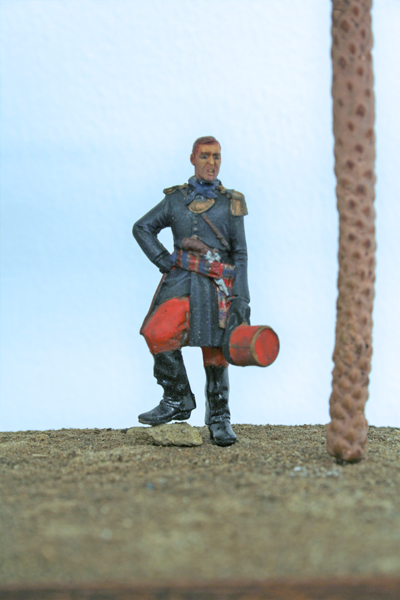
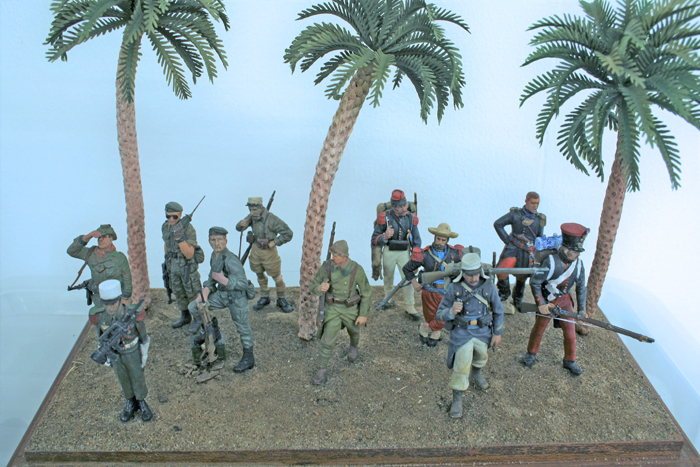
The Crimea 1854
The figure represents a Legionnaire in the Russian Steppes in the Summer. He wears the veste (short tunic) which was the common form of undress uniform. The Airfix 95th rifleman body was used, mated to the legs of the Napoleonic French Grenadier Guards. The cap was scratch-built from modelling putty. Historex accessories were used.
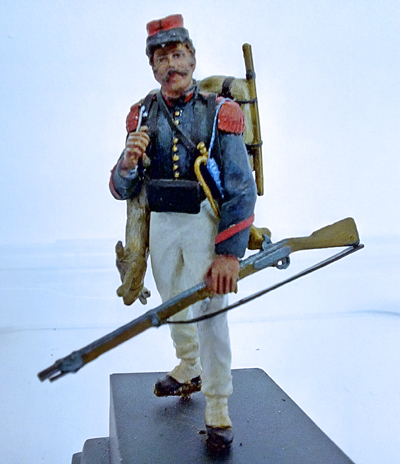
Mexico 1860s
In the hope of expanded French influence in the Americas, the French ruler Napoleon III, nephew to Napoleon Boneparte, loaned the Legion to Mexico’s ruler Maximillian. Once again the Legion was left in neglect and suffered huge losses from disease and illness before being withdrawn.
It was during the Mexican campaign at Cameron that Captain Danjou leading 62 men and two officers, vastly out-numbered and out-gunned fought to the last man while acting as escort to a supply column. The engagement became the most revered action in the history of the Legion.
The figure is a stock figure from ——–. The uniform, highly impractical, shows the flamboyant influence of the French king. Note the replacement of the shako with a more practical local sombrero.
The Foreign Legion continued to play key roles in France’s colonial expansion. In Tonkin (Vietnam) 25,000 Chinese Black Flag soldiers invaded prompting France to declare Tonkin a French Protectorate. France would remain embroiled in the region until the mid 1950’s. Similarly after occupying Morocco then declaring it a protectorate in 1912 to secure peace across the border with Algeria, the Legion would be at the forefront of keeping the peace.
The Airfix Legionaire represents the classic image of the desert soldier in the early 1900’s popularised by the film “Beau Geste”. The second figure is that of a seargent in the desert uniform worn in Algeria during its fight for independence. The third figure represents the camouflage uniform worn by the Legion paratroopers just before the withdrawal from the Tonkin region then in North Africa. The latter two figures are stock figures from Chota Sahib.
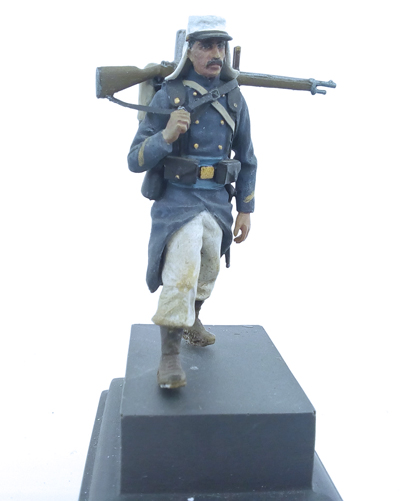
Two World Wars
The Legion saw action in Europe during both World Wars. Having started the First World War in a Horizon Blue uniform, it ended the war in a more practical Khaki uniform. The figure used is the Airfix Legionnaire seen above with Historex parts used to replace the stand and fall collar, belt buckle the trousers amended to take puttees.
The second figure is produced by “Warriors” with the rifle scratch-built in 54mm scale.
The figure is dressed in a mix of British and French items having joined the Allied Forces under De Gaul.
The 1990s
The last two figures represent the dress and combat uniform of the Legion at the end of the Twentieth Century. The Legion has held onto its traditions, one of the most cherished being that white Kepi or cap.
In summary, the Legion more than any other part of the French military forces were responsible for the creation of France’s colonial power and also in ending it.
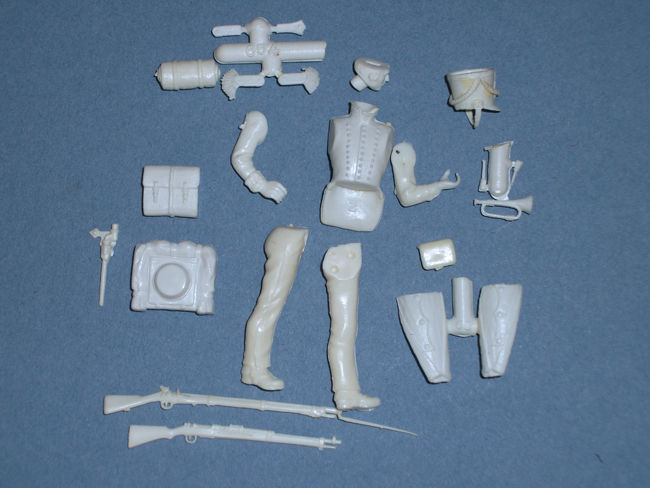
A selection of parts used in the conversion of the figures.
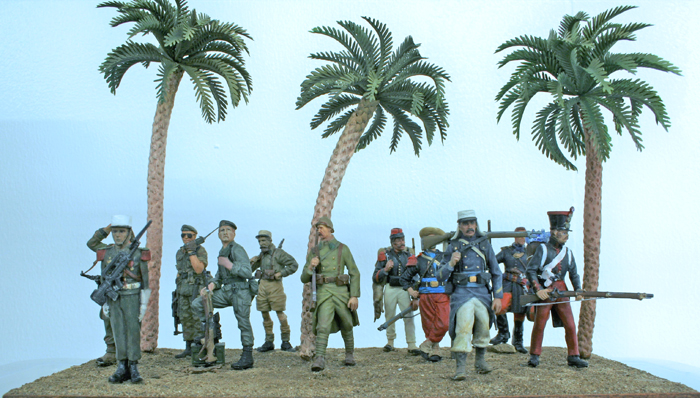
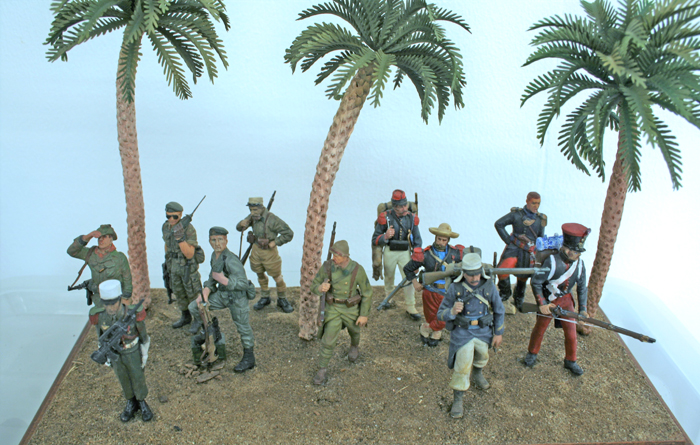
Steve N.
Ask a question or add feedback:
You must be logged in to post a comment.